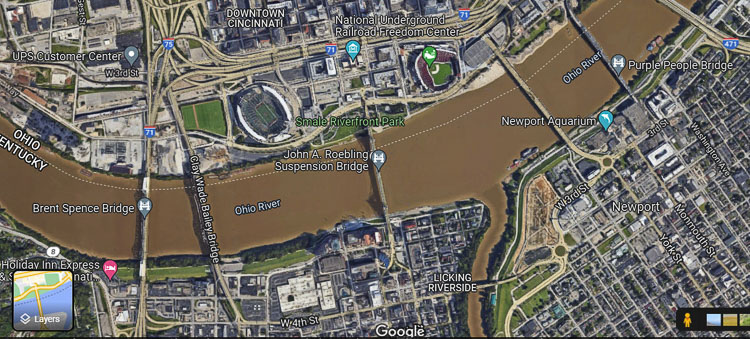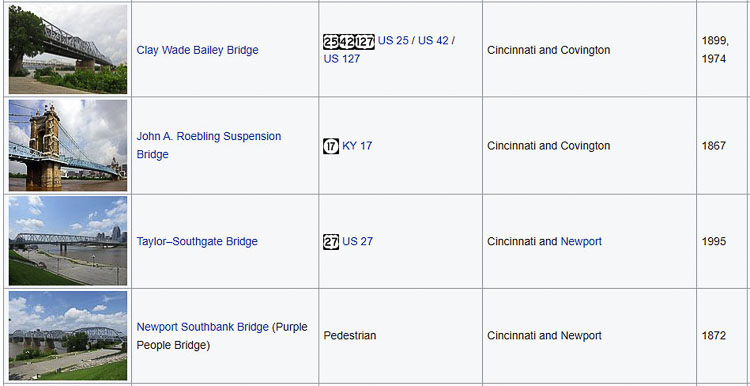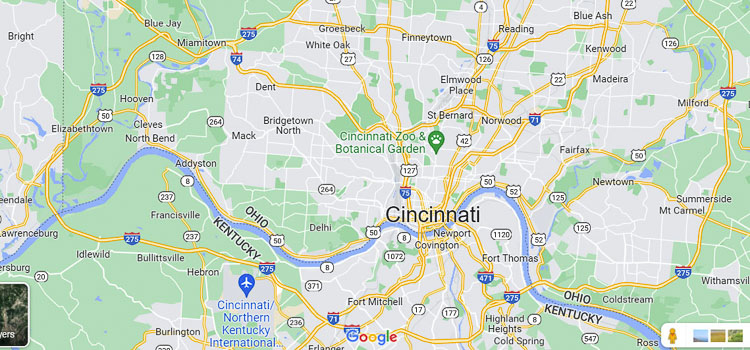Will the new Brent Spence Bridge take money from IBR?
There is a national competition for federal dollars allocated by Congress in the $1.2 trillion Infrastructure Investment and Jobs Act (IIJA). The program created a new $12.5 billion bridge investment program, of which at least half would be reserved for certain large projects, according to the Federal Highway Administration. There’s another $27.5 billion in a separate bridge repair or replacement program. Multiple states are competing for these federal transportation dollars.
The Portland metro area has roughly 2.6 million people. The Cincinnati area has just over 2.2 million. The Columbia River separates Southwest Washington from Portland and has two bridges to connect the states. The Ohio River separates northern Kentucky from Cincinnati and has seven bridges to connect their communities. They want to add an eighth bridge.
Here in the Portland metro area, citizens will be footing the bill to tear down the I-5 Interstate Bridge and replace it with a new bridge. The Interstate Bridge Replacement (IBR) will have three through lanes, just like the current bridges, which reached their design capacity back in the 1990s. More details will be revealed on April 21.
The initial finance package said “if” the previous Columbia River Crossing (CRC) proposal were built today, it could cost between $3.2 billion and $4.8 billion. The funding is expected to require tolling, but that was before the IIJA was passed by Congress. Each state was told they would need to raise at least $1 billion as their share of the undefined project. Washington has allocated $1 billion, and also has an additional $100 million from the 2015 “Connecting Washington” gas tax increase.

Presently, there are over 300,000 vehicles using the two bridges across the Columbia River on an average day. By 2060, old CRC projections estimated 550,000 vehicles crossing the river. Vehicles using the I-5 bridge average between 130,000 and 140,000 daily. It’s been 40 years since a new transportation corridor and vehicle capacity were added to the Portland metro area with the construction of the I-205 bypass.
Included in the IBR proposal will be some form of high capacity transit. According to the IBR team there is “significant demand” for high capacity transit, in spite of a ridership decline for both local transit agencies. The IBR’s November 2021 report showed 3,200 people using transit on the I-5 Bridge corridor. C-TRAN ridership peaked in 1999 and TriMet ridership peaked just over a decade later.
Ohio River project
In Ohio and Kentucky, it’s a very different story. More than 160,000 motor vehicles cross the I-71/I-75 Brent Spence Bridge (BSB) daily, though its original design was meant to accommodate half that number – 80,000 vehicles per day. The current bridge has four lanes in each direction. The new structure will be the eighth bridge across the Ohio river connecting northern Kentucky with Cincinnati and appears to add six lanes in each direction.
“A companion Brent Spence Bridge adds capacity and flexibility for carrying interstate and local lanes over the Ohio River. This in turn will improve safety for local traffic traveling across the river and entering or exiting the interstate by reducing merges and weaving. Both local commutes and long-distance travel will benefit from the Brent Spence Bridge Project.”
Two concepts were developed with different lane configurations at the Ohio River crossing. These concepts do not change the access points provided in the preferred alternative nor do they change the concept of creating a collector-distributor system that separates the interstate through traffic from the local street connections.
A collector distributor is what transportation architect Kevin Peterson has suggested for the IBR.
The new Brent Spence Bridge (BSB) will be constructed next to the existing bridge. The 8-mile transportation corridor project study began back in 2004. It appears to add six lanes in each direction, a 150 percent increase in vehicle capacity on the interstate freeway across the river to relieve traffic congestion.
It was originally expected the new BSB would require tolling to cover part of the cost of construction. An Ohio Toll Diversion Model used to generate traffic and revenue forecasts for a 50-year horizon from the original planned opening date of 2018. The results showed BSB diversion rates between 22 and 26 percent. That would equate to about 137,000 vehicle diversions here in the Portland metro area by 2060, when Oregon and Washington expect around 550,000 daily vehicles crossing the Columbia River.
The current BSB corridor is listed as the second worst bottleneck in the nation for freight, according to a 2021 study by the American Transportation Research Institute. In the Portland metro area, the Interstate Bridge is number 23; the I-84/I-5 interchange is number 28 and the I-5/I-205 interchange near Wilsonville is number 84 in the nation.
At a Feb. 28 news conference, the Ohio and Kentucky governors announced they would be seeking two federal grants for $2 billion to fund roughly 70 percent of the new bridge cost. They informed citizens the new bridge would not require tolling to help pay for construction. The two states will fund whatever is not covered by federal funds.
Two options have been proposed for the new Brent Spence Bridge over the Ohio River. The project team has produced these two videos showing both options. This video shows the history of bridges in both regions, and then the two options under consideration in Cincinnati. Video courtesy Brent Spence Bridge project.
Bridge history
The current Brent Spence Bridge opened in 1963, just six years after the newest half of the I-5 Interstate Bridge structure. In the 1990’s, it was declared “functionally obsolete” because of its narrow lanes and having no emergency lanes, just like the Interstate 5 Bridge.
Two of the seven bridges crossing the Ohio River are older than the original span of the Interstate Bridge, which opened in 1917.
The John A. Roebling Suspension Bridge was started before the CIvil War and opened in 1867. The Purple People Bridge (Newport Southern Bridge) is an overhead truss style structure and was built in 1872.
After nearly 14 months of remodeling and upgrades, the John A. Roebling Bridge connecting Cincinnati to Covington will reopen this coming Friday afternoon according to an area news report. It normally carries about 8,100 vehicles a day over the Ohio River.
“It’s amazing that at 155 years old, this beautiful bridge is still a vital connection,” said Bob Yeager, chief district engineer of the Department of Highways District 6 in Covington. “We know that the businesses and citizens of Covington and Cincinnati are ready for the Roebling to be reopened.”
After the original Brent Spence Bridge was built in 1963 as part of the new interstate freeway system, the Cincinnati region built five more bridges. The Portland metro area built one, the I-205 Glenn Jackson Bridge.
The Cincinnati area created a “ring road” allowing vehicles to bypass the crowded downtown corridor. The two I-275 bridges were built in 1977 and 1979. A second shorter bypass was built – I-471 which opened in 1976 and then was extended in 1980.
Portland built the eastern half of a ring, I-205 which opened in late 1982. The western bypass was canceled as anti-car activists continued their push for light rail transit, following their victory stopping the Mt. Hood Freeway.
Transit
There is transit service between Ohio and Kentucky. One map shows nine bus lines using the Brent Spence I-71/75 Bridge. Eleven bus lines use the CW Bailey bridge. Six bus lines each use the Taylor Southgate and the Daniel Beard bridges. That’s 32 bus lines crossing the river for transit service into Cincinnati.
Here in the Portland metro area, C-TRAN offers the only service. It had seven bus lines until the pandemic lockdowns caused them to reduce and consolidate cross river service.
It does not appear there will be any high capacity transit component to the new Brent Spence Bridge project.

The Federal Highway Administration (FHA) will ultimately review requests for funding major bridge projects and spread the money among numerous projects around the nation. Will they favor a project that will add vehicle capacity and help relieve traffic congestion? Or will they see that Cincinnati has seven bridges and choose to favor the Portland metro area that only has two?
Will they appreciate a region that has preserved its historic bridges, two of which are roughly a half century older than half the Interstate 5 Bridge? Or will they favor the destruction of a bridge that is on the national historic register?
Will the FHA prefer the IBR because they are proposing tolling, allowing the FHA to contribute less IIJA funding to this project and spread the money among more projects?
Will the FHA provide more money to fix the second worst freight corridor in the nation? Or will it provide more money for the IBR which will provide almost no time savings, and will still run into the 28th worst bottleneck at the I-5/I-84 bottleneck at the Rose Quarter?
The Rose Quarter project is roughly $800 million over budget at $1.25 billion, and is also seeking federal funding. They will add no new through lanes to I-5 as well.
Greg Johnson has indicated his IBR team will seek high capacity transit funding later this summer. They hope the Oregon legislature steps forward with a comparable $1 billion in their 2023 session, as Washington lawmakers did during their recent session.
For the bridge itself, they will need to submit a Supplemental Environmental Impact Statement (SEIS) before they can formally begin chasing federal dollars. Other critical decisions will be obtaining a permit from the US Coast Guard, which has a mandate to protect marine traffic navigating the river.
Initial details on the bridge structure will be revealed later this month. That may or may not include information about the cost of building the IBR team’s suggested “solution” to replace the Interstate Bridge.

Also read:
New law protects docs who prescribe ivermectin, hydroxychloroquine






“The Interstate Bridge Replacement (IBR) will have three through lanes, just like the current bridges, which reached their design capacity back in the 1990s.”
The proposed bridge replacement with the same number of thru lanes is unlikely to reduce congestion.
Another bridge, creating a western by-pass, would help to relieve congestion and greatly improve freight efficiency.
C-TRAN proposes permanent cuts in cross river service clearly shows that the weak demand for bus service on I-5 between WA and OR has been stagnant pre-pandemic, and in 2020 was less than 1/3 of that, just 971 trips across, which is only 485 roundtrips. That is NO justification for high capacity transit.
Clark County voters rejected high capacity gold plated light rail at the ballot box, twice. Every city in Clark County rejected the proposition.
We need affordable transportation projects based on realistic future demand projections.
See State Auditor confirms Sound Transit light rail ridership forecasts are unrealistic
Public Transit ridership will depend on how long transit times are. RIght now it takes too much time to get from East Vancouver to PDX, downtown Portland, Beaverton or Troutdale by public transportation.
Fuel prices are another important factor.